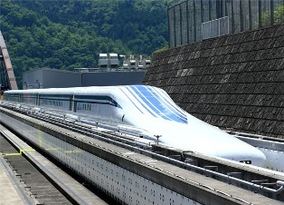 toyokeizai.net
toyokeizai.net With Australia’s resources boom coming to a (temporary) end (temporary in the sense that if India decides to start importing large quantities of raw materials then once again Australia might experience a boom similar to that experienced with China), it is abundantly clear that Australia needs to diversify its economy if it is to have any chance of escaping the cycles of boom and bust that accompany the raw material trade. For a nation that is growing in population, and concurrently in ambition, there is a need to ensure that the more remote areas of the nation are more closely linked to the major population centres on the coastal fringe. To that end, there needs to be a conduit established between major population centres that will allow for the mass transportation of people from city to city, and city to country, without the environmental effects of either automobiles or aircraft or the considerable delays experienced by the current rail network.
Australia has been examining the potential of high speed rail transport since the early 1980s. Private studies, coupled with state and federal government sponsored studies, have reached various conclusions based on a number of factors; the engineering involved in construction and maintenance, the potential number of passengers, negotiations between state and federal governments over costs, and legal aspects arising from environmental impact statements, compensation claims from rural properties affected by noise and pollution and compensation for land claimed as part of the planning process. Despite the clear benefits of having such a railway network (as outlined in this 2013 DOI report), one factor has consistently acted as a brake on high speed rail becoming a reality: political will.
Put simply, because high speed rail would involve a considerable amount of investment from government (state and federal), neither level of government has been particularly enthusiastic about taking it up as a means of nation-building. A federal government review of the feasibility of high speed rail concluded in 2001 that it would cost around AU$51bn to build a such a network between Sydney, Canberra, and Melbourne, and that these costs, coupled with the relatively low number of passengers, therefore made it an economic impossibility. Federal governments, wary about imposing an additional tax to pay for the construction of such a network, have consistently delayed making any decision about high speed rail, instead insisting that only private funding could support such a project.
For a nation such as Japan, which embarked on nation building through infrastructure projects during the 1950s and which completed its first Shinkansen line in 1964 (J), the saga of Australia’s on-again, off-again relationship with high speed rail has been instructive, especially when it comes to dealing with foreign governments and the question of wills.
Nevertheless, Japan is certainly ready to provide the planning, engineering, maintenance, and management of a high speed railway that Australia needs. While other countries (namely China and France) have also expressed an interest in being involved in any future high speed railway network for Australia (a sore point for Japanese railway industries in the case of China, whose companies the Japanese accuse of stealing Japanese technology), Japan’s long history of operating high speed rail networks, its impeccable safety record, and the future potential of Japanese designed high speed trains all point towards Japanese industries being given priority in any future Australian high speed rail network.
Yet nothing can begin if the political will is not there to support infrastructure building. This is an issue that needs to be resolved, yet 35 years of deliberation, obfuscation, and procrastination has prevented it from progressing any further than as a topic for conversation. It does not augur well for the Australian nation if issues of national importance such as an effective, efficient transport network, geared towards population growth, urban development, and the movement of capital from cities to the country, cannot progress any further than as a talking point for a research paper.
 RSS Feed
RSS Feed